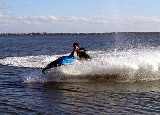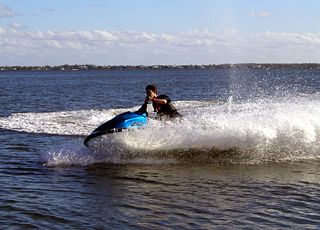
Clayton Jacobson II
Encyclopedia
Clayton Jacobson II is credited with inventing the personal water craft
, including both the sit-down and stand-up models.

and dirt bike rider who looked to translate his hobby to water. Though he enjoyed dirt bike racing as a form of stress relief, he hoped bringing it to water would do away with the hard crashes. The original idea was designed in the mid-1960s, powered by an internal pump-jet
rather than an outboard motor, made of all aluminum, and had a fixed, upright handle. Jacobson eventually quit his job in banking to devote himself to developing the idea, and had a working prototype by 1965. It differed slightly from modern personal watercraft but had definite similarities. He completed a second prototype a year later made of fiberglass.
In 1967 he was approached by the Bombardier Corporation
, which manufactured the Ski-Doo snowmobile. He developed a sit-down craft known as the Sea-Doo, which went on sale in 1968. The design had a round hull as opposed to the more conventional V-shaped hull, strakes, a very narrow body, and a high length-to-beam ratio. The model has since come to be referred to as the turtle, perhaps from the appearance of the overturned hull in the water. However the design suffered from some problems, as it was reportedly underpowered and rather unwieldy with its rounded hull. The original model contained an 18 hp, 318 cc Rotax
, air-cooled engine, though the design may have suffered from mechanical problems and poor components and materials. Bombardier's main focus at this time was on the larger snowmobile market, and the Sea-Doo only saw a limited production between 1968 and 1970. The product was dropped shortly after and the rights to the invention then reverted to Jacobson in 1971.
and sold off his patent rights to them. He developed a stand-up personal watercraft
, similar to his original concept design, for Kawasaki branded the Jet Ski
. The difference was that it featured a collapsible vertical pole which swung down onto the deck of the craft. The design was meant to be for a more personal craft, and had room for only one person. Jacobson and Kawasaki created six different prototypes in 1972, before bringing two to market in 1973, the WSAA and the WSAB. He later alleged in court that Kawasaki terminated the agreement and told him his patents were not needed. He filed suit against them in 1976, and settled in 1979. Kawasaki nevertheless remained the exclusive manufacturer of PWCs until Jacobson made a licensing agreement with Yamaha in 1986. With the success of the Jet Ski, Bombardier relaunched the Sea-Doo in 1988. Up till 1991, Jacobson earned about US$3 million in royalties on the PWC over the years.
Jacobson filed another lawsuit against Kawasaki and two of its American subsidiaries in 1989, claiming they had improperly obtained patents for the Jet Ski in Japan and named its own employees as the inventors. The former claims were dismissed by the judge, but on the latter Jacobson was awarded US$7.5 million in compensatory damages and US$13.5 million in punitive damages by a jury in July 1991 for libel and slander. However the ruling was overturned by a US judge in September of the same year, stating evidence was insufficient and ordered for a new trial. The two sides reached a settlement in August 1992. No payment amounts were disclosed, but Kawasaki Motors Corp. U.S.A. agreed to acknowledge Jacobson invented the Jet Ski, and all charges against Kawasaki were dropped.
Personal water craft
A personal water craft , also called water scooter, is a recreational watercraft that the rider rides or stands on, rather than inside of, as in a boat....
, including both the sit-down and stand-up models.

Early design and prototypes
Jacobson was a banker from ArizonaArizona
Arizona ; is a state located in the southwestern region of the United States. It is also part of the western United States and the mountain west. The capital and largest city is Phoenix...
and dirt bike rider who looked to translate his hobby to water. Though he enjoyed dirt bike racing as a form of stress relief, he hoped bringing it to water would do away with the hard crashes. The original idea was designed in the mid-1960s, powered by an internal pump-jet
Pump-jet
A pump-jet, hydrojet, or water jet, is a marine system that creates a jet of water for propulsion. The mechanical arrangement may be a ducted propeller with nozzle, or a centrifugal pump and nozzle...
rather than an outboard motor, made of all aluminum, and had a fixed, upright handle. Jacobson eventually quit his job in banking to devote himself to developing the idea, and had a working prototype by 1965. It differed slightly from modern personal watercraft but had definite similarities. He completed a second prototype a year later made of fiberglass.
In 1967 he was approached by the Bombardier Corporation
Bombardier Recreational Products
Bombardier Recreational Products or BRP is a Canadian company that traces its roots back to the year 1942 when Joseph-Armand Bombardier founded L'Auto-Neige Bombardier Limitée in Valcourt in the Eastern Townships, Quebec.In 2003, Bombardier Inc...
, which manufactured the Ski-Doo snowmobile. He developed a sit-down craft known as the Sea-Doo, which went on sale in 1968. The design had a round hull as opposed to the more conventional V-shaped hull, strakes, a very narrow body, and a high length-to-beam ratio. The model has since come to be referred to as the turtle, perhaps from the appearance of the overturned hull in the water. However the design suffered from some problems, as it was reportedly underpowered and rather unwieldy with its rounded hull. The original model contained an 18 hp, 318 cc Rotax
Rotax
BRP-Powertrain GmbH & Co KG , commonly known simply as Rotax, is an Austrian engine manufacturer. It develops and produces four-stroke and advanced two-stroke engines for Bombardier Recreational Products products as well as for motorcycles, karts,...
, air-cooled engine, though the design may have suffered from mechanical problems and poor components and materials. Bombardier's main focus at this time was on the larger snowmobile market, and the Sea-Doo only saw a limited production between 1968 and 1970. The product was dropped shortly after and the rights to the invention then reverted to Jacobson in 1971.
Later developments
Though he continued to refine the idea, Jacobson could not make an agreement with another manufacturer until the end of the exclusive license with Bombardier in 1971. The day after it expired he went into a partnership with KawasakiKawasaki Heavy Industries
is an international corporation based in Japan. It has headquarters in both Chūō-ku, Kobe and Minato, Tokyo.The company is named after its founder Shōzō Kawasaki and has no connection with the city of Kawasaki, Kanagawa....
and sold off his patent rights to them. He developed a stand-up personal watercraft
Stand-up PWC
Stand-up PWC are a type of personal watercraft available since the 1970s. They have a pivoting handlepole and standing tray area that requires the operator to stand while riding instead of sitting. This is in contrast to the more frequently seen "sit-down" type of PWC. Both these terms are...
, similar to his original concept design, for Kawasaki branded the Jet Ski
Jet ski
Jet Ski is the brand name of a personal watercraft manufactured by Kawasaki Heavy Industries. The name is sometimes mistakenly used by those unfamiliar with the personal watercraft industry to refer to any type of personal watercraft; however, the name is a valid trademark registered with the...
. The difference was that it featured a collapsible vertical pole which swung down onto the deck of the craft. The design was meant to be for a more personal craft, and had room for only one person. Jacobson and Kawasaki created six different prototypes in 1972, before bringing two to market in 1973, the WSAA and the WSAB. He later alleged in court that Kawasaki terminated the agreement and told him his patents were not needed. He filed suit against them in 1976, and settled in 1979. Kawasaki nevertheless remained the exclusive manufacturer of PWCs until Jacobson made a licensing agreement with Yamaha in 1986. With the success of the Jet Ski, Bombardier relaunched the Sea-Doo in 1988. Up till 1991, Jacobson earned about US$3 million in royalties on the PWC over the years.
Jacobson filed another lawsuit against Kawasaki and two of its American subsidiaries in 1989, claiming they had improperly obtained patents for the Jet Ski in Japan and named its own employees as the inventors. The former claims were dismissed by the judge, but on the latter Jacobson was awarded US$7.5 million in compensatory damages and US$13.5 million in punitive damages by a jury in July 1991 for libel and slander. However the ruling was overturned by a US judge in September of the same year, stating evidence was insufficient and ordered for a new trial. The two sides reached a settlement in August 1992. No payment amounts were disclosed, but Kawasaki Motors Corp. U.S.A. agreed to acknowledge Jacobson invented the Jet Ski, and all charges against Kawasaki were dropped.

